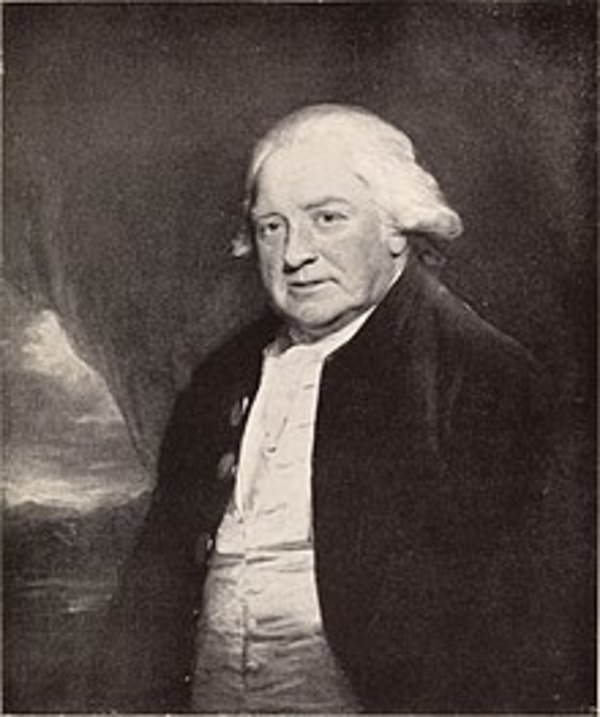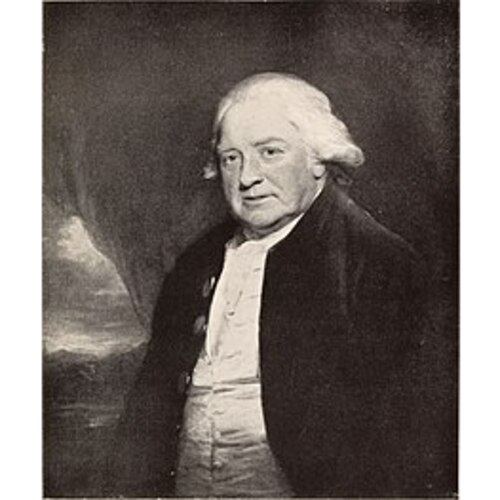
Source: Courtesy of Wikimedia Commons
BERKELEY, Sir GEORGE CRANFIELD, naval officer; b. 10 Aug. 1753, third son of Augustus Berkeley, 4th Earl of Berkeley, and Elizabeth Drax; m. 23 Aug. 1784 Emilia Charlotte Lennox, sister of Charles Lennox, and they had two sons and three daughters; d. 25 Feb. 1818 in London, England.
After his education at Eton College, George Cranfield Berkeley entered the Royal Navy in 1766. From 1767 to 1769 he served on the Guernsey under Hugh Palliser* at Newfoundland, and in 1774 he was promoted lieutenant. In 1780 he became a captain, and the same year commanded the sloop Fairy off Newfoundland, capturing nine American privateers. Promoted rear-admiral in 1799 and vice-admiral in 1805, in 1806 he was named commander of the North American squadron, his first independent command.
When Berkeley reached his headquarters at Halifax, N.S., in July 1806, Britain’s relations with the United States were strained owing to smuggling and the refitting of French warships in American ports. One of his first letters to the Admiralty spoke of the Îles de la Madeleine as “a receptacle for the smuggled produce of the States of America, and of course a most essential injury to our Newfoundland and Nova Scotia fishery.” His attention, however, focused on Chesapeake Bay, where in September a French squadron, much battered by a hurricane, took refuge and underwent repairs. In order to watch the enemy force he moved his headquarters to Bermuda, where he remained until May 1807.
With his ships blockading the French and thus having to put into American ports for wood, water, and other necessary provisions, some desertion inevitably occurred. Berkeley demanded the return of the deserters, several of whom had enlisted in the United States Navy. No article of any treaty between the United States and Great Britain required the surrender of such deserters, but the American government had permitted French naval officers to reclaim their deserters on land. Berkeley resolved that, if necessary, force would be used to assert this right at sea. Thus, when in June 1807 the United States frigate Chesapeake sailed from Norfolk, Va, with a crew that included some English deserters, she was challenged by one of Berkeley’s squadron, the Leopard. In Berkeley’s words, the Leopard “proceeded to search her, and was by the pertinacity of the American Captain compelled to use force.” Three American seamen were killed, with one officer and 12 seamen wounded. The fury unleashed in the United States by this action caused Berkeley, now back in Halifax, to fear the immediate outbreak of general hostilities; and he at once applied to the Admiralty for reinforcements. “The Province of Nova Scotia,” he remarked, “which contains our only Arsenal, can only be attacked from the Bay of Fundy, where it will be necessary to have a constant naval force.” This unhappy altercation, of little consequence, added perhaps a dram to the growing cupful of American grievances that characterized the years leading to war in 1812. In British North America, however, the provincial administrations considered the situation serious enough for active military preparations to be undertaken, and in 1808 the British government sent troop reinforcements to the provinces.
Berkeley was transferred from his North American post and promoted to command the squadron on the coast of Portugal from 1808 to 1812. Upon his retirement from active life at sea he was named lord high admiral of Portugal by a grateful ally. He was appointed a knight of the Bath on 1 Feb. 1813.
Berkeley had a long career in parliament, though there is no record that he ever spoke in the House of Commons. In 1774 he had been a candidate at Cricklade, but withdrew the day before the poll. In 1776 he lost a very expensive contest for Gloucester. He was finally elected unopposed there in 1783, and held the seat until 1810.
He died on 25 Feb. 1818. The details of his will indicate a considerable fortune, much of which was left to his son George Henry Frederick.
[A considerable amount of material relating to Berkeley’s naval career survives outside the PRO. In the MTL, the Sir George Cranfield Berkeley papers, 1806–12, cover four inches of shelf space. Five letter-books and order-books are in the National Library of Scotland (Edinburgh), Dept. of mss, mss 9932–36, while the Warwickshire County Record Office (Warwick, Eng.) has letters catalogued as CR 114A/165–67, 348, 574, 616–17, and 632(6) in the Seymour of Ragley papers. The National Maritime Museum holds a number of items, including AGC/1 (G. C. Berkeley, corr., 1804); AGC/B/3 (G. C. Berkeley, corr. and account of the Peninsular War, December 1808–May 1812); KEA/9 (G. C. Berkeley, letters to Keats, 1800); LBK/36 (G. C. Berkeley, order-book, 15 Jan. 1809–8 Aug. 1810); YOR/2 (G. C. Berkeley, letters to Yorke). A calendar of his North American papers is published in American Hist. Assoc., Annual report (Washington), 1900, 1: 608–23. j. g.]
PRO, ADM 1/496: ff.453, 614; 1/497: ff.271–72, 425–28; ADM 6/21–25; PROB 11/1604/216. DNB. L. [B.] Namier and John Brooke, The House of Commons, 1754–1790 (3v., London, 1964), 2: 85.
Cite This Article
Julian Gwyn, “BERKELEY, Sir GEORGE CRANFIELD,” in Dictionary of Canadian Biography, vol. 5, University of Toronto/Université Laval, 2003–, accessed April 29, 2025, https://www.biographi.ca/en/bio/berkeley_george_cranfield_5E.html.
The citation above shows the format for footnotes and endnotes according to the Chicago manual of style (16th edition). Information to be used in other citation formats:
| Permalink: | https://www.biographi.ca/en/bio/berkeley_george_cranfield_5E.html |
| Author of Article: | Julian Gwyn |
| Title of Article: | BERKELEY, Sir GEORGE CRANFIELD |
| Publication Name: | Dictionary of Canadian Biography, vol. 5 |
| Publisher: | University of Toronto/Université Laval |
| Year of revision: | 1983 |
| Access Date: | April 29, 2025 |



